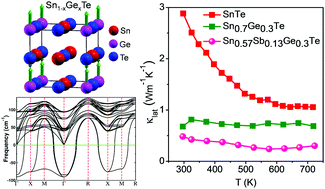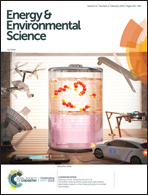Engineering ferroelectric instability to achieve ultralow thermal conductivity and high thermoelectric performance in Sn1−xGexTe†‡
Abstract
High thermoelectric performance of a crystalline solid requires it to have low thermal conductivity which is one of the utmost material challenges. Herein, we demonstrate how the local structural distortions and the associated ferroelectric lattice instability induced soft polar phonons effectively scatter the heat carrying acoustic phonons and help achieve ultralow lattice thermal conductivity in SnTe by engineering the instability near room temperature via Ge (x = 0–30 mol%) alloying. While Sn1−xGexTe possesses a global cubic structure above room temperature (x < 0.5), by analysing synchrotron X-ray pair distribution functions (PDFs) we showed that local rhombohedral distortion exists which is sustained up to the studied maximum temperature (∼600 K) above the ferroelectric transition (TC = 290 K). We showed that the local rhombohedral distortions in global cubic Sn1−xGexTe are predominantly associated with local Ge off-centering which forms a short-range chain-like structure and scatters acoustic phonons, resulting in an ultralow lattice thermal conductivity of ∼0.67 W m−1 K−1. In addition, Sb doping in Sn1−xGexTe enhances the Seebeck coefficient due to p-type carrier optimization and valence band convergence, which leads to a synergistic boost in the thermoelectric figure of merit, zT, to ∼1.6 at 721 K. The concept of engineering ferroelectric instability to achieve ultralow thermal conductivity is applicable to other crystalline solids, which opens up a general opportunity to enhance the thermoelectric performance.



 Please wait while we load your content...
Please wait while we load your content...